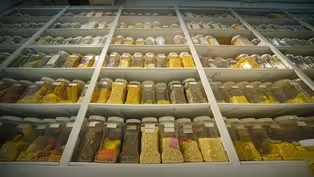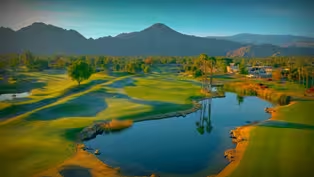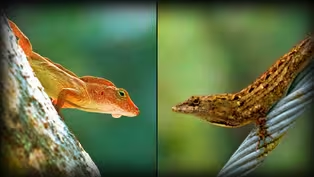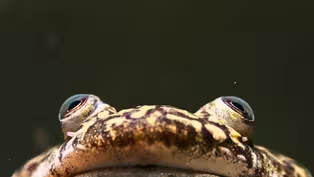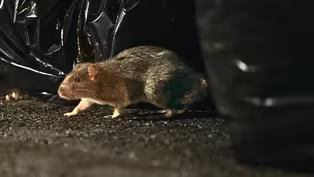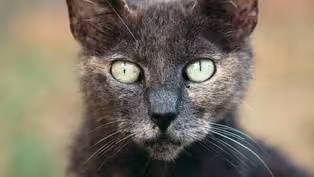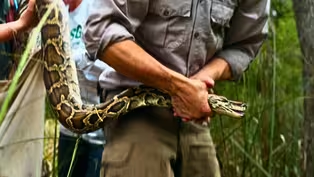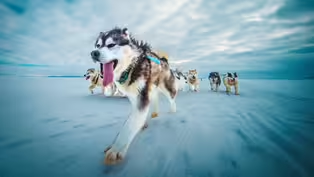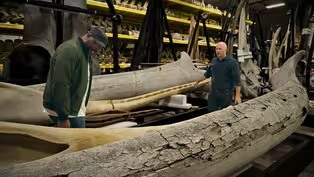
We Brought This Fish To America. Now We Can't Get Rid Of It
Special | 10m 39sVideo has Closed Captions
Expose Asian carp for disrupting native fish species and shrinking their populations.
The invasive Asian carp, once introduced as a solution, is now disrupting native fish species and shrinking their populations across rivers, streams, and lakes along the Mississippi River Basin. Join Shane as he visits a safeguarded battlefront in a lab, gears up for a thrilling fishing tournament, and devours a gourmet delicacy. Innovative solutions emerge in the conundrum against this intruder.
Problems playing video? | Closed Captioning Feedback
Problems playing video? | Closed Captioning Feedback

We Brought This Fish To America. Now We Can't Get Rid Of It
Special | 10m 39sVideo has Closed Captions
The invasive Asian carp, once introduced as a solution, is now disrupting native fish species and shrinking their populations across rivers, streams, and lakes along the Mississippi River Basin. Join Shane as he visits a safeguarded battlefront in a lab, gears up for a thrilling fishing tournament, and devours a gourmet delicacy. Innovative solutions emerge in the conundrum against this intruder.
Problems playing video? | Closed Captioning Feedback
How to Watch Human Footprint
Human Footprint is available to stream on pbs.org and the free PBS App, available on iPhone, Apple TV, Android TV, Android smartphones, Amazon Fire TV, Amazon Fire Tablet, Roku, Samsung Smart TV, and Vizio.
Buy Now

Surprising Moments from Human Footprint
Do you think you know what it means to be human? In Human Footprint, Biologist Shane Campbell-Staton asks us all to think again. As he discovers, the story of our impact on the world around us is more complicated — and much more surprising — than you might realize.Providing Support for PBS.org
Learn Moreabout PBS online sponsorshipMore from This Collection
Video has Closed Captions
Watch the rise of a productive crop that has managed to replace itself, but at what cost? (11m 24s)
The Watery Price Of Golf Courses & Lawns
Video has Closed Captions
The cultural and resource costs for manicured lawns and golf courses are quite shocking. (11m 29s)
How Dogs Are Shaping The Future Of Medicine
Video has Closed Captions
Observe the rich diversity of dog breeds, shaped by genes and human intervention. (12m 43s)
Why Are These Urban Lizards Evolving in Overdrive?
Video has Closed Captions
Examine city-dwelling anoles with remarkable evolutionary changes. (10m 33s)
How An Ancient Ocean Shaped Us History
Video has Closed Captions
Learn how millions of years of deposits shaped the events of Black American history. (16m 54s)
Video has Closed Captions
What happens when frogs become indispensable? (8m 59s)
Video has Closed Captions
When it comes to NYC, the rat is the undisputed king! (13m 26s)
Your Cat’s Secret Life (as a Deadly Predator)
Video has Closed Captions
Cats have been winning the hearts of humans for years....but can devastate ecosystems. (10m 40s)
Singapore: Designing a Megacity in Harmony with Nature
Video has Closed Captions
Green spaces aren't just an afterthought here - they're mandatory! (13m 24s)
How Giant Pythons Became Florida’s Biggest Invasive Species
Video has Closed Captions
Ever heard of the phrase "when pet pythons outgrow their owners"? (13m 24s)
Sled Dogs: The Most Extreme Distance Athletes on Earth
Video has Closed Captions
In the Arctic, it's not just about muscle power, but brainpower too. (15m 17s)
Secrets of the World’s Only Whale Warehouse
Video has Closed Captions
Uncover the history of whaling and its impact on our oceans. (9m 58s)
Providing Support for PBS.org
Learn Moreabout PBS online sponsorshipWe have a series of technologies, sound, bubbles, electricity and a flushing lock.
Like they're literally running a gauntlet.
… none of which by itself has a 100% guarantee.
But layering them together provides a variety of challenges to overcome.
You can imagine this lab like a moat, trying to keep enemies out of a castle.
But who are these enemies?
They have a unique characteristic between their air bladder and their inner ear.
Icall it the echo chamber.
That sound is amplified into their inner ear in a way that causes them to leap out of the water.
You know, they react to noise.
That was a beamer!
Now, when I signed up for this gig, I did not agree to get smacked in the face by a giant fish.
But if you live in the Mississippi river basin, your chances of getting carp-slapped are definitely not zero.
That’s because in some places, invasive carp now make up 60 to 70% of the river’s biomass.
These fish have transformed the ecosystem and the lives of people who work and play on the river.
So today, we’re waging a high-tech war on carp to keep them out of the Great Lakes.
But the solution to the carp problem… might not be technological.
I’m Shane Campbell-Staton, and this is Human Footprint.
Hey, Andrew.
What's happening, man?
Not too much.
How are you doing?
Just went to a Redneck Fishing Tournament, got smacked in the face by a carp.
Andrew Reeves is a Canadian journalist who spent 10 years writing a book about Asian carp.
We have this umbrella term of Asian carp, but it really doesn’t do the individual species justice.
Four species were imported from Asia to American waters: black, grass, bighead, and silver carp.
They were perhaps one of the last invasive species that were actually brought over with the full-throated support of government and the scientific community.
Each species was brought here with a specific job to do.
And let’s just say, the silver carp drew the short straw.
You can't just dump solid waste into your local waterway anymore.
You can use these fish to be able to clean up those sewage lagoons.
Just so I’m clear, they wanted to use the carp to eat human waste?
That’s right.
And around that time, someone also had the idea of could we also eat them if they're eating nothing but human waste?
Nobody wants to eat poop fish.
No.
And this was it.
And so they've kind of had this trash fish reputation.
If the carp had just stayed in their sewage lagoons, we might not be having this conversation.
But politics gave the fish an unexpected opportunity.
I would like to have a crusade today… and it would be one to take government off the backs of the great people of this country.
Ronald Reagan slashed the number of regulations that the EPA could enforce.
And essentially all the research that was being done on silver and bighead just evaporated overnight.
All of a sudden, they had tens of thousands of fish, and nothing to do with them.
So, some people essentially opened the sluice gates on their properties, and we're still suffering the consequences of that today.
In just a few decades, carp had spread through the Mississippi River and most of its tributaries.
Today, the front lines of the war on carp are just south of Chicago.
Well, what does the fish say when it runs into something in the river?
Dam!
I met Scott Whitney at the Brandon Road Lock and Dam.
Scott isn’t just a purveyor of bad puns, he’s also been fighting invasive species for decades with the Army Corps of Engineers.
Scott’s marching orders?
Use whatever means necessary to stop the carp from entering the Great Lakes, where scientists worry their impact could be catastrophic.
We have one chance to stop that movement at this point.
The Great Lakes wouldn’t be at risk if carp were just spreading up the historic Illinois river.
The problem is, we’ve re-engineered the river, connecting it with Lake Michigan through a massive system of canals and locks.
Before Scott and his team build any carp barriers in the real world, they have to test them in the lab.
How much did it cost to build the infrastructure?
This particular project has about an $800 million price tag, right now.
It's a tall order, but the investment right now is the least costly it’s ever gonna be.
It’s only gonna get bigger from here on.
While some might call the consequences ‘unforeseen,’ they were predictable.
So is what will happen if carp overwhelm the Great Lakes.
In fact, the invasion by another species is already underway.
In the 1980s, the discovery of zebra mussels in the Great Lakes Region sparked an ecological red alert.
Similar to the invasive carp, these unassuming mussels rapidly established their dominance, outpacing native species in their ability to mature and reproduce.
As the zebra mussels encroach upon critical infrastructure, they serve as a stark reminder of the far-reaching consequences that invasive species can have.
If we’ve learned anything from the zebra mussels, it’s that we have to put all our boots on the ground to prevent another disastrous outcome.
Some of these battles involve familiar players, like the Army Corps of Engineers.
And other times, the battlefield looks a little different.
What do you do for a living?
I am a professor at Princeton.
Oh, really?
Yeah.
How’d they trick you into doing this?
This is the Redneck Fishing Competition.
An event that’s quintessentially American, centered around a fish that’s… definitely not.
We’re official.
We’re in it… in it to win it!
My guide is Lance Gregerson, a local fisherman.
And we’re off!
Off like a herd of turtles.
Do you consider yourself a redneck?
Hell yeah!
You proud to be a redneck?
Yeah!
The goal here is simple: catch as many carp as possible in mid-air.
Get 'em?
Ha ha!
Good shot.
Hell of a good time!
But catching carp…that’s just the beginning.
To make a dent in the population, there has to be a market for it.
And right now, people are working hard to cook that market up.
The new name for Asian Carp is Copi.
That’s C-O-P-I.
It’s short for copious, which is exactly what this fish is.
Copi burgers, copi sliders, copi fajitas, copi tacos.
And even copi po’ boys.
To test the waters, Illinois is cooking up carp - I mean “copi” - for one population that’s always hungry: college students.
You should do the hard part, I don’t want to show you up on TV, so you do the hard part.
Even the hard part I have a hard time with too, so.
This is Chef Soowha Yu.
He’s got a green thumb and he’s a magician in the kitchen, transforming carp into something folks here on campus actually like to eat.
I’ll show you how to filet this one.
Okay.
So, you’ve got to be careful, there’s some bones right here.
It’s really heavy bones right here you gotta - Okay, so you’re working around the bone Oops sorry.
Oh yeah, that’s a thick bone, geez.
There’s a really hard bone right there.
Then you follow the bone and then you’re gonna hear this one, two - that’s bone.
Chef Yu really knows his way around those bones.
There you go.
Oh wow.
I’ve been hearing people talk about how bony the fish is.
Chef Yu has been busy for over half a decade finding tasty ways to serve this fish.
This is a fried copi.
A little savory and salty.
And there’s bone there.
Just make sure - Okay.
Oh, it smells delicious.
I’m on a diet, so I had a smaller piece.
Okay.
Dig in.
Let’s see what we got here.
So make sure you don’t see any bones on it.
Oh, that's good.
It's succulent.
Okay, definitely got to make your way around the bones though.
I see.
See, normally the Asian, what we do is eat the whole fish in the mouth.
Okay.
And you just move around.
And then you work through it.
Like this.
Okay.
You can’t be uppity with somebody pulling bones out of your mouth.
Yeah.
Carp have been a staple of East Asian cuisine for centuries, and I can taste why.
It’s hard to believe Americans haven’t embraced this fish and that little bit of extra work it takes to enjoy it.
We're in the Midwest.
We're meat and potato guys.
But now we have a lot of fish out there, so we have to eat it up.
Is picking bones out a little more work?
Sure.
But listen, it’s good fish, and I’m saying that as a dude who literally got smacked in the face by one.
So give carp – sorry, copi – a try, at least once.
Because a funny, not-so-funny thing happened when we were putting this video together… New evidence pointing to a possible copi invasion was found in the Great Lakes.
One thing’s clear.
The battles ahead will be fought in labs, on the river, and at the dinner table.
Maybe, instead of vilifying the species that succeed where they don’t belong, we should take a closer look at why they’re there in the first place.
And how our species is handling the fallout.
Thanks for watching.
If you want more Human Footprint, you can tune in to the full length-series on the PBS app or on your local PBS station.

- Science and Nature

Explore scientific discoveries on television's most acclaimed science documentary series.

- Science and Nature

Capturing the splendor of the natural world, from the African plains to the Antarctic ice.












Support for PBS provided by:
